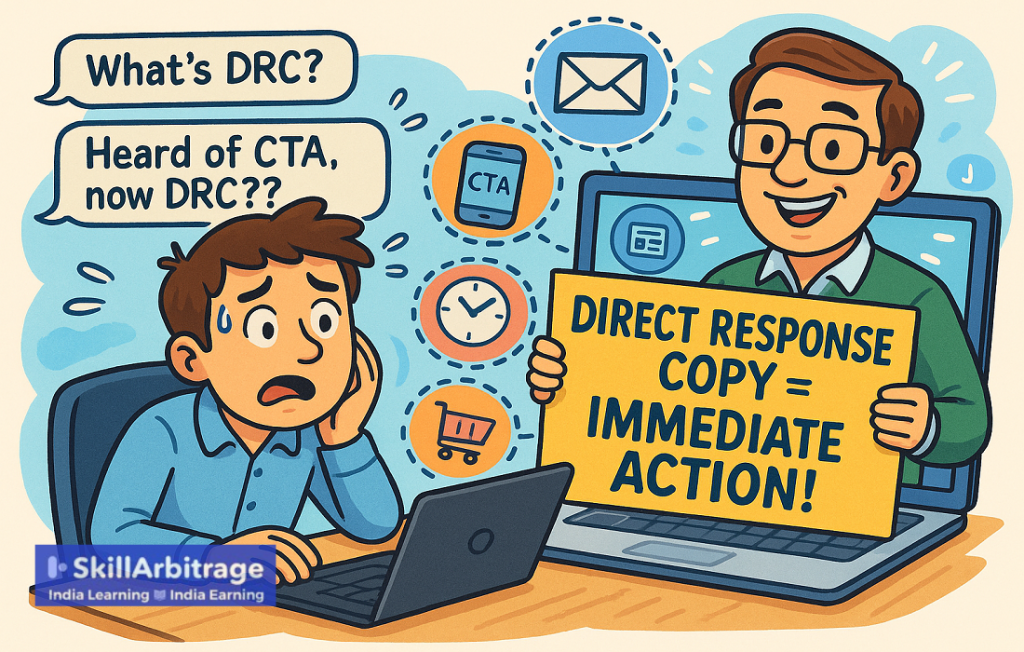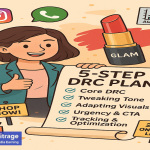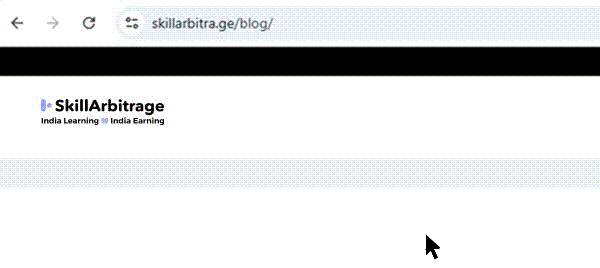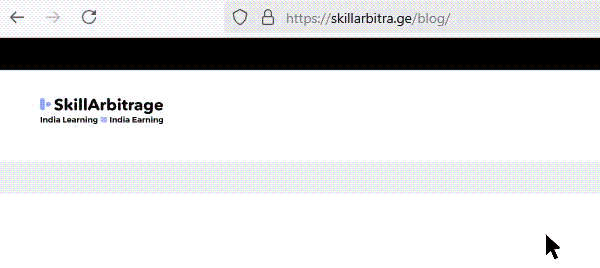This blog takes a practical approach to understanding the benefits and crafting failsafe Direct Response Copywriting content to drive fast action from the audience. It would be useful for content writers, strategists, and even small brand owners who want maximum impact at a minimal budget.
Table of Contents
Introduction
“Hey, what’s DRC?”
A long-time associate reached out frantically over WhatsApp.
Before I could reply, more messages started pouring in. “ Have heard about CTA, what’s DRC now? I swear, people are now just making it difficult!”
The person on the other end of the line had a small agency and had recently onboarded a U.S. startup, eager to meet their marketing needs.
And apparently the first Zoom call has flabbergasted the person.
Because…you guessed it, “DRC”!
I decided to go on another Zoom call to put his mind at rest.
He was clearly shaken, so I told him first what DRC was.
It was nothing but a Direct Response Copy. Now a rage, around the world!
It was quite simple, really. Instead of a copy to boost brand image, DRC was the copy that prompted action.
All he said to that was “Huh?”
So I decided to elaborate further.
What is Direct Response Copywriting
Direct Response Copywriting is a copywriting technique designed to prompt immediate action from the reader, such as making a purchase, signing up for a newsletter, or clicking a link.
It focuses on clear, persuasive messaging that highlights benefits, creates urgency, and includes a strong call-to-action (CTA).
Unlike the copywriting we did for brands, it aimed for measurable and trackable results. Basically, any copy that prompted the reader to take action quickly or was used for quick conversions with scarcity tactics, and targeted appeals was DRC or Direct Response Copywriting.
Like sales emails, landing pages, and ads with phrases like “Buy Now” or “Limited Offer.”
And that was the stuff that drove conversions and boosted ROIs.
In fact, there were several benefits.
Why do brands need Direct Response Copywriting?
Well, simply because they work. At the end of the day, every brand needs to sell things to simply remain afloat. For small startups in India and abroad who had to drive results on a shoestring budget, this was a failsafe method to drive more clicks.
DRC drives immediate and measurable results
Unlike traditional brand advertising, where we focus on long-term awareness, direct response copywriting prompts instant actions (e.g., clicks, purchases, or subscriptions). This allows brands to track conversions, response rates, and ROI in real time.
Increases conversion rates
By using persuasive techniques like emotional triggers, strong CTAs, and addressing pain points, direct response copywriting boosts conversion rates as well.
Long-form direct response copy can actually generate 7.6% better conversions than shorter content, as shown in a split test by Neil Patel comparing 1,292-word vs. 488-word content.
Cost-effective marketing
Direct response copywriting is a boon for brands because it is super cost-effective. It requires a lower investment than traditional advertising (e.g., billboards or TV ads), making it ideal for small businesses and startups.
Builds trust and credibility
DRC drives conversions, and that can’t happen without trust. By incorporating social proof (e.g., testimonials, case studies) and addressing customer pain points, direct response copywriting establishes brand authority while fostering trust.
Fosters customer relationships and loyalty
Personalized, reader-focused copy (like using “you” statements) creates a sense of emotional connection, encouraging long-term engagement and loyalty.
Enables continuous optimization
This form of copywriting also supports A/B testing and data-driven adjustments, allowing brands to refine campaigns for better performance.
Creates urgency and emotional engagement
If it does not create urgency, it is not Direct Response Copywriting. Techniques like scarcity, time-limited offers, and emotional storytelling compel immediate action by tapping into psychological triggers.
“But how does it work?” he asked, “ I mean, on what medium?”
“ On all actually.” I replied.
And it was true that DRC worked across most mediums.
Mediums where DRC is commonly used
Here is a breakdown of where direct response copywriting is commonly used and how it functions in those areas.
Email Marketing
Emails delivered personalized messages directly to a recipient’s inbox, often addressing their specific needs or pain points, which makes it perfect for DRC.
Examples:
- Sales emails with limited-time offers like “24-Hour Flash Sale: Save 50% Now.”
- Abandoned cart reminders such as “Complete Your Purchase Before It’s Gone.”
- Newsletters with calls-to-action (CTAs) like “Shop Now” or “Claim Your Discount.”
Landing Pages
These single-purpose pages focus entirely on driving one action, such as capturing leads or promoting a product. Another great medium for Direct Response Copies.
- Examples:
- Webinar sign-up pages with CTAs like “Register Now to Secure Your Spot.”
- eBook downloads with “Get Your Free Guide Today.”
- Product launches featuring “Buy Now” or “Start Your Free Trial.”
Social Media Ads
We often see ads on platforms like Facebook or Instagram use precise targeting to reach the right audience with compelling copy and visuals. That was another area where DRC worked great.
- Examples:
- Sponsored posts with “Limited Offer: Shop Now.”
- Ads encouraging users to “Learn More” or “Get Your Discount.”
Search Engine Ads (PPC)
Pay-per-click ads appear when users search for solutions, aligning with their immediate intent and driving conversions, which means DRC.
- Examples:
- Google Ads like “Affordable Web Design Services” with CTAs such as “Get a Free Quote.”
- Ads prompting “Sign Up Today” for relevant services.
Sales Pages
Long-form sales pages provide detailed information, address objections, and guide readers to purchase, making DRC crucial here.
- Examples:
- High-ticket item pages with “Order Now and Save $500.”
- Service pages with testimonials and “Book Your Consultation.”
Direct Mail
Physical mail, like postcards or catalogs, stands out and creates urgency or exclusivity to drive quicker responses. But this was very rarely used by brands with strong online presence.
- Examples:
- Offers like “Order by Friday for 20% Off.”
- Letters with CTAs such as “Call Now” or “Visit Us Today.”
Video Scripts
Videos use emotion, visuals, and sound to push for immediate action. So scripts for these videos would fall in the DRC bracket.
- Examples:
- YouTube ads ending with “Subscribe for More” or “Visit Our Site.”
- Promotional videos with “Join the Movement.”
Pop-Ups and Banners
Extensively used by brands, these grab attention at key moments on websites, encouraging quick decisions.
- Examples:
- Pop-ups with “Get 10% Off Your First Order.”
- Banners offering “Claim Your Free Trial.”
SMS Marketing
Text messages are used to deliver time-sensitive offers with high open rates.
- Examples:
- “Flash Sale: 30% Off Ends Tonight.”
- Event reminders like “Reply YES to Confirm.”
Affiliate Marketing
Affiliates often use tailored messages in niche markets to drive action through trusted recommendations.
Examples:
- Blog posts with “Buy Through This Link for a Discount.”
- Influencer promotions like “Use Code XYZ for 15% Off.”
Direct response copywriting works really well in all these areas precisely because it capitalizes on targeted reach, personalization, immediacy, and measurable results.
Whether it’s the urgency of an SMS, the focus of a landing page, or the trust built in a sales page, this technique is all about getting the audience to act right away.
“So you mean it can apply to any medium. It’s the nature of the copy rather than the actual difference in medium. Hmm, makes sense.” He said.
“Yes, exactly, it’s about what the copy does instead of where you see it,” I replied.
“ Isn’t that too salesy or pushy?” was his next question.
“Yes, and that works when you want to drive quick action,” I replied.
“But how do I tell my writers to do this?” He asked.
“It’s really simple, you know, there are steps. Let’s assume we wanted to write DRC for a fitness brand” I continued.
The step-by-step plan
These are the twelve steps anyone needs to follow to write a perfectly plausible Direct Response Copy which I shared with my associate, to share with the writers working with him, in turn.
Step 1: Define goal
The first step in this is all about clarity.
Identify the specific action you want the reader to take. This could be buying a product, subscribing to a service, or downloading a resource. Every element of your copy should drive toward this goal to ensure focus and effectiveness.
Example: If you are selling a fitness program, your goal might be to get readers to “Sign Up for a Free Trial.”
Step 2: Understand your audience
The second step is always delving deep into the audience’s psyche, and that can only happen with solid research.
Research your target audience to understand their pain points, desires, and motivations. Use surveys, customer feedback, or market research to gather insights. Tailoring your message to their needs makes it more relevant and persuasive.
Example: For a fitness program, your audience might be busy professionals who want quick, effective workouts. Highlight how your program saves time and delivers results.
Step 3: Craft compelling headline
Write a headline that grabs attention and entices the reader to continue. It should be clear, benefit-driven, and create curiosity or urgency. The headline is the first thing readers see and determines whether they engage further.
Example: “Get Fit in Just 15 Minutes a Day – Start Your Free Trial Now!”
Step 4: Write engaging opening
The first paragraph is often what seals the deal.
Use the opening paragraph to hook the reader.
Start with a relatable story, a surprising fact, or a question that addresses their pain points. A strong opening keeps the reader interested and sets the tone for the rest of the copy.
Example: “Struggling to find time for the gym? Imagine transforming your body with just 15 minutes a day – no equipment needed.”
Step 5: Highlight benefits over features
Don’t talk to people about what you offer, tell them what you can do for them instead.
Focus on how your product or service improves the reader’s life. Explain the benefits clearly and emotionally.
Benefits connect with the reader’s desires and motivations, making the offer more appealing than a list of features, which is difficult for a layman to understand.
Example: Instead of saying “Our program includes 50 workout videos,” say “Achieve your dream body with quick, effective workouts designed for busy schedules.”
Step 6: Address objections
There are many doubts and anticipation that can cloud the audience’s mind before they make the decision you want them to make.
Anticipate and counter any concerns or doubts the reader might have, such as cost, time commitment, or effectiveness. Addressing objections builds trust and removes barriers to action.
Example: “Worried about the cost? Our program is priced lower than a single gym session, and you can try it free for 7 days.”
Step 7: Create urgency
Encourage immediate action by using scarcity, limited-time offers, or exclusive bonuses. Urgency reduces procrastination and increases conversion rates.
Example: “Sign up today to claim your free workout guide – available only to the first 100 members!”
Step 8: Include a clear Call-to-Action (CTA)
Tell the reader exactly what to do next using action-oriented language. Make the CTA stand out and eliminate any confusion about the next step.
Example: “Click Here to Start Your Free Trial” or “Get Instant Access Now.”
Step 9: Use persuasive language and AIDCA framework
Direct Response Copy is all about urgency, urgency, and more urgency and the way to do this was by following the AIDCA framework in long-form content.
AIDCA is an acronym for “attention, interest, conviction, desire and action.” Ideally, you want all five in your copy. Start with an attention-grabbing headline, then drive interest with a compelling product or service hook.
If you’re creating longer-form copy, conviction can be built by using customer testimonials or reviews, but this isn’t necessary for quick-hitter content.
Desire speaks to your value proposition — why would customers want your product or service? Action is your goal; clarify the specified action and provide direct links.
So, incorporate words that evoke emotion and urgency, such as “you,” “free,” “now,” “limited,” and “exclusive.” Persuasive language enhances the emotional appeal and drives action.
Example of a quick hitter: “Don’t miss out on this limited-time offer – transform your life today!”
Example of a long-form content (email) using AIDCA: “ Subject: Too Busy for the Gym? Get Fit in 15 Minutes a Day!
Attention:
Struggling to squeeze workouts into your packed schedule? You’re not alone.
Interest:
Imagine transforming your body without spending hours at the gym. FitFast’s 15-minute workouts are designed for busy professionals like you—proven to burn fat and build strength, no equipment needed.
Desire:
Picture yourself feeling confident, energized, and in control of your health—all with workouts that fit your lifestyle. FitFast offers expert-led routines, tailored meal plans, and a community to keep you motivated. Plus, our limited-time offer includes a free workout guide for the first 100 sign-ups. Don’t miss out on the body you deserve!
Conviction:
Over 10,000 users have already seen results, with 85% reporting more energy in just two weeks.
Action:
Click here to start your 7-day free trial now—only 50 spots left! Join FitFast today and take the first step to a fitter, happier you.”
Step 10: Add social proof
Trust is a great motivator. Always include testimonials, reviews, or case studies from satisfied customers to build credibility whenever you can. Social proof reassures the reader that others have benefited from your offer. Refer also to the example shared in the last step.
Example: “Join over 10,000 happy customers who’ve achieved their fitness goals with our program.”
Step 11: Ensure readability
No one reads Direct Response Copy for the pleasure of reading. Here clarity comes way before cleverness or creativity.
Use short paragraphs, bullet points, and subheadings to make the copy easy to scan and digest. Readable copy keeps the reader engaged and ensures they absorb key points.
Example: Break down benefits into a bulleted list:
- Save time with 15-minute workouts.
- No equipment needed.
- Expert guidance from certified trainers.
Step 12: Test and refine
This is the golden step. Use A/B testing to compare different versions of your copy and optimize based on performance. Testing helps identify what resonates best with your audience, improving results over time.
Example: Test two headlines – one focusing on time-saving and another on results – to see which drives more sign-ups.
Conclusion
I am happy to report that the plan worked and my associate did not stumble over DRC any more.
Mastering the art of direct response copywriting is a game-changer for anyone looking to drive immediate results.
By understanding your audience, crafting compelling headlines, highlighting benefits, and using persuasive techniques like urgency and social proof, you can create copy that not only captures attention but also converts readers into customers.
The key lies in clarity, emotional connection, and a relentless focus on prompting action. As you apply these strategies, remember to test and refine your approach to maximize impact.
Start implementing these principles today, and watch your campaigns transform into powerful tools for growth and engagement.
FAQs
1. What’s the #1 reason my audience isn’t taking action, even though my copy is well-written?
A: You’re writing to inform, not to motivate. Direct response copy must create emotional urgency—a reason to act now. Add frictionless CTAs, remove passive voice, and inject stakes. Ask: “What will they lose if they don’t act today?”
2. How do I make my CTAs so irresistible that people have to click?
A: Use value-packed CTAs tied to immediate benefit. Don’t say “Learn More”—say:
“Get the 3-step cheat sheet now” or
“Start saving ₹5,000/month today”.
Make it action-oriented, time-bound, and ultra-specific.
3. How do I use urgency without sounding like a sleazy marketer?
A: Use genuine urgency triggers:
- Limited spots
- Deadline-based bonuses
- Launch periods
But anchor it in truth. E.g., “Enrollment closes in 48 hours. After that, this won’t reopen until July.”
4. Can I use FOMO if my offer isn’t expiring?
A: Absolutely. Use social proof FOMO:
- “12,000 marketers already downloaded this.”
- “Join 1,500+ freelancers who doubled their income.”
This creates implied momentum—even if there’s no timer.
5. How do I warm up a cold audience before pushing them to buy?
A: Use a 2-step copy sequence:
- Educate (value-driven content or lead magnet)
- Transition to a low-risk offer (free trial, demo, ₹99 masterclass).
Always earn trust before asking for the wallet.
6. How can I make long-form sales pages convert faster?
A: Front-load the emotional hook and promise.
The first 200 words should answer:
- What is this?
- Why should I care?
- What will I get today?
Then, use bolded copy, cliffhangers, and testimonials to maintain momentum.
7. My audience reads my copy but still hesitates. How do I kill that hesitation?
A: Use the 5H Framework:
- Headline
- Hook
- Help (value)
- Hurdles (address objections)
- Hero CTA
Identify what’s making them stall—then crush it with FAQs, money-back guarantees, or logic stacks.
8. What’s the best way to start a Facebook or Google ad to grab instant attention?
A: Start with a pattern interrupt + specific problem:
“Still wasting hours writing emails that don’t convert?”
“Your resume isn’t the problem. Your positioning is.”
Use pain-focused openers to jolt attention.
9. How do I write for scanners who don’t read word-for-word?
A: Use the Z-pattern layout:
- Headlines every few scrolls
- Bullet points
- Highlighted benefits
- Big bold CTAs
And always break text with visuals or icons for scroll-stopping engagement.
10. What’s one quick editing trick to make my copy more persuasive?
A: Replace every “we” or “our” with “you” or “your.”
Then apply this test: Does every paragraph push the reader toward the CTA? If not—cut it.
11. Should I write like I speak or keep it formal for credibility?
A: Write how your audience speaks when they’re frustrated, excited, or about to make a decision.
If your reader says “I just want this done already,” that’s your tone. Think coffee shop, not conference room.
12. How do I A/B test direct response copy without draining my budget?
A: Focus on high-leverage variables:
- Headlines
- CTA buttons
- Lead paragraph
Run tests on email subject lines or landing pages with heatmaps. Tools like Google Optimize, VWO, or even Instagram story polls work for early signals.







 Allow notifications
Allow notifications
